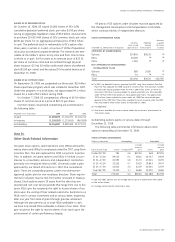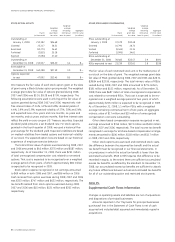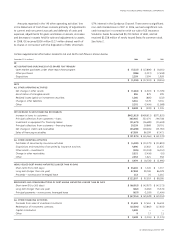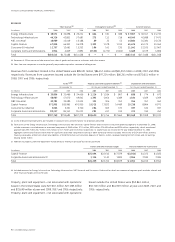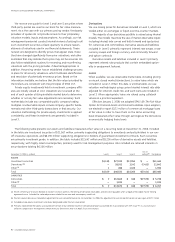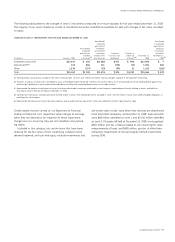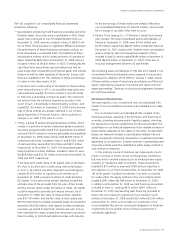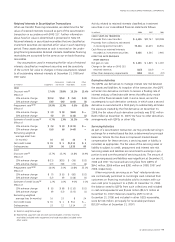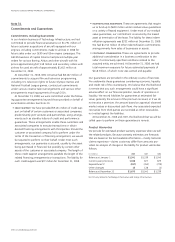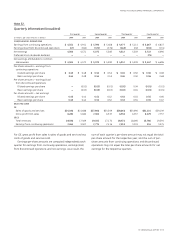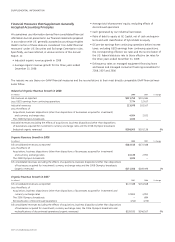GE 2008 Annual Report Download - page 97
Download and view the complete annual report
Please find page 97 of the 2008 GE annual report below. You can navigate through the pages in the report by either clicking on the pages listed below, or by using the keyword search tool below to find specific information within the annual report.
ge 2008 annual report 95
notes to consolidated financial statements
LOAN COMMITMENTS
Notional amount
December 31 (In millions) 2008 2007
Ordinary course of business lending
commitments (a) (b) $ 8,507 $ 11,731
Unused revolving credit lines(c)
Commercial 25,011 24,554
Consumer —principally credit cards 252,867 477,285
(a) Excluded investment commitments of $3,501 million and $4,864 million as of
December 31, 2008 and 2007, respectively.
(b) Included a $1,067 million secured commitment associated with an arrangement
that can increase to a maximum of $4,943 million based on the asset volume
under the arrangement.
(c) Excluded inventory financing arrangements, which may be withdrawn at our
option, of $14,503 million and $14,654 million as of December 31, 2008 and 2007,
respectively.
Derivatives and Hedging
We conduct our business activities in diverse markets around
the world, including countries where obtaining local funding is
sometimes inefficient. The nature of our activities exposes us to
changes in interest rates and currency exchange rates. We
manage such risks using various techniques including issuing
debt whose terms correspond to terms of the funded assets, as
well as combinations of debt and derivatives that achieve our
objectives. We also are exposed to various commodity price risks
and address certain of these risks with commodity contracts.
By policy, we do not use derivatives for speculative purposes.
We value derivatives that are not exchange-traded with internal
market-based valuation models. When necessary, we also obtain
information from our derivative counterparties to validate our
models and to value the few products that our internal models
do not address.
We use interest rate swaps, currency derivatives and commod-
ity derivatives to reduce the variability of expected future cash
flows associated with variable rate borrowings and commercial
purchase and sale transactions, including commodities. We use
interest rate swaps, currency swaps and interest rate and currency
forwards to hedge the fair value effects of interest rate and
currency exchange rate changes on local and non-functional
currency denominated fixed-rate borrowings and certain types
of fixed-rate assets. We use currency swaps and forwards to
protect our net investments in global operations conducted in non-
U.S. dollar currencies. We intend all of these positions to qualify
as hedges and to be accounted for as hedges.
We use swaps, futures and option contracts, including caps,
floors and collars, as economic hedges of changes in interest rates,
currency exchange rates and equity prices on certain types of
assets and liabilities. We sometimes use credit default swaps to
economically hedge the credit risk of various counterparties
with which we have entered into loan or leasing arrangements.
We occasionally obtain equity warrants as part of sourcing or
financing transactions. Although these instruments are derivatives,
their economic risks are similar to, and managed on the same
basis as, risks of other equity instruments we hold. These instru-
ments are marked to market through earnings.
Earnings Effects of Derivatives Designated as Hedges
The following table provides information about the earnings
effects of derivatives designated and qualifying as hedges.
PRE-TAX GAINS (LOSSES)
December 31 (In millions) 2008 2007 2006
CASH FLOW HEDGES
Ineffectiveness $ 8 $ (3) $ 10
Amounts excluded from the measure
of effectiveness 5(17) (16)
FAIR VALUE HEDGES
Ineffectiveness (600) 7 (47)
Amounts excluded from the measure
of effectiveness (26) (13) 33
Ineffectiveness primarily related to changes in the present value
of the initial credit spread over the benchmark interest rate
associated with hedges of our fixed rate borrowings.
In 2008, 2007 and 2006, we recognized insignificant gains
and losses related to hedged forecasted transactions and firm
commitments that did not occur by the end of the originally
specified period.
Guarantees of Derivatives
We do not sell credit default swaps; however, as a part of our
risk management services, we provide performance guarantees
to third-party financial institutions related to plain vanilla interest
rate swaps on behalf of certain customers related to variable rate
loans we have extended to them. The underwriting risk inherent
in these arrangements is essentially similar to that of a fixed rate
loan. Under these arrangements, the guarantee is secured, usually
by the asset being purchased or financed, or by other assets of
the guaranteed party. In addition, these agreements are under-
written to provide for collateral value that exceeds the combination
of the loan amount and the initial expected future exposure of
the derivative. These credit support arrangements mature on the
same date as the related financing arrangements or transactions
and are across a broad spectrum of diversified industries and
companies. The fair value of our guarantee is $28 million at
December 31, 2008. Because we are guaranteeing the performance
of the customer under these arrangements, our exposure to loss
at any point in time is limited to the fair value of the customer’s
derivative contracts that are in a liability position. The aggregate
termination value of such contracts at December 31, 2008, was
$386 million before consideration of any offsetting effect of
collateral. At December 31, 2008, collateral value was sufficient
to cover the loan amount and the fair value of the customer’s
derivative, in the event we had been called upon to perform under
the guarantee. If we assumed that, on January 1, 2009, interest
rates moved unfavorably by 100 basis points across the yield curve
(a “parallel shift” in that curve), the effect on the fair value of such
contracts, without considering any potential offset of the under-
lying collateral, would have been an increase of $161 million.
Given our strict underwriting criteria, we believe the likelihood that
we will be required to perform under the guarantee is remote.
Additional information regarding our use of derivatives is
provided in Note 18 and Note 23.


